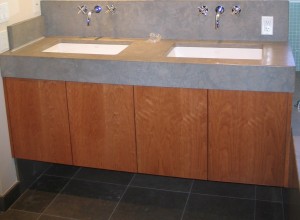Architects and designers since the beginning of civilization have used natural stone for their most important works. Natural stones such as granite, marble, sandstone and limestone offer unparalleled natural beauty straight from Mother Earth. Advances in technology have helped make the labor-intensive process much more affordable making it more affordable than ever to the modern day consumer. Among the many advantages of stone are it’s natural beauty, easy maintenance, ability to be installed in virtually any application and its ability to increase the value of your home.
Igneous rock
Ideal choice for kitchen counters, floors or any heavily used areas
Harder than most other commonly used stones
Heat resistant
Scratch resistant
Granite can be highly polished to expose all of its natural characteristics, honed for a matt finish or flame-textured for an aged, antique finish. These finishes are sometimes combined to produce interesting patterns and features.

Metamorphic rock made up of calcite crystal
Ideal for bathroom countertops, tubs and showers, fireplace facings and walls
Should not be used in applications where mild acids are used, such as kitchens and bars, as etching can occur
Typically softer and more porous than granite therefor can stain and scratch more easily
It is normally white, but often tinted by iron oxide, carbon and serpentine to form attractive shades of yellow, brown, green or black. Other minerals may grow from impurities within the stone often resulting in coloured streaks or veins. Marble is usually finely crystalline, hard and dense and consequently can be highly polished.

Sedimentary rock formed over millions of years from fine grains of sand bonded together by minerals of natural cement. It is the composition of this “cement” which determines the colour and hardness of each sandstone. Some of the harder sandstones are rich in quartz and feldspar, two minerals that are also commonly found in granite.
Sandstone is used in areas where a durable, non-slip, low maintenance surface is required. Popular examples include flooring and wall cladding, landscape features like patios, terraces, balconies and paths and both internal and external swimming pool surrounds.
Slate and Soapstone
Sedimentary rock, compressed and compacted over time and altered by metamorphism (a combination of heat and pressure) to form a very hard rock
Slates can vary in color depending on the different minerals that were introduced during their metamorphosis. Bright colors such as greens, reds, yellows and purples can be found, as well as the more common greys and blacks.
Highly heat and chemical resistant
Good for fireplaces
Slate is generally harder than other sedimentary rocks like Limestone and Sandstone

Travertine is a sedimentary stone that is a form of limestone When limestone is put under a lot of pressure for thousands of years, it can turn into travertine. Travertine occurs in areas where limestone is common and where circulating ground water contains calcium carbonate. It often forms around the mouths of hot springs and in streams. Rock formations called stalactites and stalagmites, which are found in caves, consist primarily of travertine. In terms of hardness, travertine is in between limestone is softer than marble yet harder than limestone.
Limestone is a sedimentary stone composed of calcium carbonate. The primary source of this calcium carbonate is an accumulation of organic materials, such as shells and coral, sand, or precipitates.






